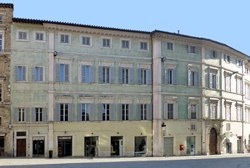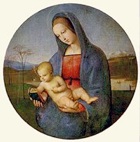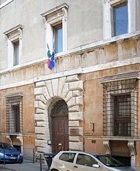

Palazzo Conestabile della Staffa I (15th century)

The Collegio del Cambio had its headquarters in buildings on this site in what is now Piazza Danti by 1361. Cherubino degli Ermanni bought the site and built the first palace here. The original entrance was in Rimbocco del Cherubino (later Via Sant’ Andrea) to the right, which was closed in 1730 when the adjacent Palazzo Friggeri was built.
The Ermanni family adopted the name “della Staffa” in the 16th century, and was joined with the Conestabile family of Terni in 1796 when Anna Maria della Staffa married Giovanni Conestabile. Their son, Francesco enlarged the palace in 1816-7.
The Emperor Francis I of Austria stayed here as a guest of Francesco Conestabile della Staffa in 1819 during his three-week stay in Perugia. This unscheduled sojourn was caused by the illness of his daughter Carolina. For this short period, Perugia was the centre of the Austrian Empire: the royal family also took over the adjacent Palazzo Friggeri, while the Chancellor, Prince Clemens von Metternich took over Palazzo Donini.
The Conestabile della Staffa family became extinct in 1870. The palace passed to the Conestabile family of Terni and the art collection that it had amassed was sold.
Conestabile Madonna (ca. 1504)

The painting depicts the half-length Madonna and Child set in a landscape. Both the Madonna and the baby Jesus attentively study the book that the former is holding. The picture was originally on a panel that was integral to an ornately gilded frame. The tondo was subsequently transferred to canvas and is now in a frame that might be the original one.
Palazzo Conestabile della Staffa II (1628-9)

The palace subsequently passed into the ownership of the Conestabile della Staffa family. They acquired the nearby ex-church of Sant’ Angelo della Pace in the early 2oth century, and became the private chapel of this palace. They gave both the palace and the ex-church to the Commune in 1969, in order to house the Biblioteca Augusta.
Frescoes (ca. 1670)
Giovanni Andrea Carlone stayed in this place as a guest of Orazio Ferretti during his stays in Perugia. Most of them have been destroyed, but one depicting the virtue of heroism survives [where?].
Return to Monuments of Perugia.
Return to: Walk I (Palazzo Conestabile della Staffa I) or
Walk II (Palazzo Conestabile della Staffa II).

